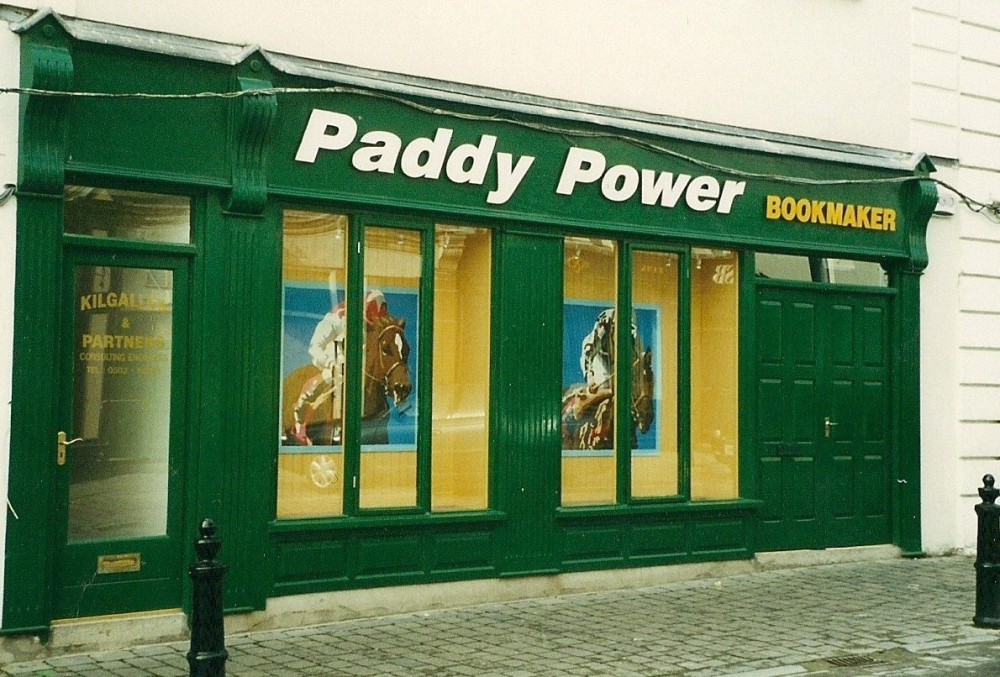From at least 1856, William Phelan was a druggist, grocer and ironmonger at his fine
three-storey residence here. After his sudden death in January 1870, his son, Town Commissioner John T. Phelan
took over the business. His wife Anne, née McMahon, was from Ballyroan. In 1876, the Phelans made the
national newspapers when a fire in their yard destroyed large quantities of hay and turf and threatened
to spread along the street. Thanks to the arrival of fire engines from the Town Commission and the military
barracks and the efforts of the police, the Queen’s County Milita and hundreds of townspeople who carried
water to the engines, what The Freeman's Journal of August 2, 1876 described as "one of the greatest dangers
that ever threatened the town of Maryborough” was “overcome and conquered".
Following John T. Phelan's death, and her subsequent marriage to John Delany from the Heath,
Anne retained the Phelan name over the door and continued the business. ("Patent medicines in great variety.
Special attention given to cattle medicines" ). In 1901, John (listed in the census as ‘farmer’) and Anne Delany
(‘shopkeeper’) were living here with her daughter Katie Phelan and their young children, Bessie, John F. and Michael
. As a young woman living in Dublin, Bessie was a member of Conradh na Gaeilge, The Gaelic League, whose
aim was to promote the use of Irish and counter what it saw as the prevalent anglicisation of Ireland.
She died of tuberculosis, aged only nineteen, and at her wake in her parent's house, the well-known revolutionary
Cathal Brugha arrived with a wreath from an Conradh. More than one hundred cars followed Bessie’s hearse
to the graveyard in the Heath.
We learn from the 1911 census that the misfortunate Anne, widowed for a second time, was still
here with her daughter Katie and son John, a bookkeeper in the family business. The household on the night
also included, inter alia, the shop manager, Thomas Kelly. The shop was, in fact, frequently referred to as
'Tommy Kelly's' and, as recalled by one of my informants, its actual proprietor was known to schoolchildren
as Auntie Delany. She died in 1916 but the shop, now run by Katie aka Kit and John, remained in business into the 1950's.
John, incidentally, was the captain of Maryborough hockey team 1923/4.
Because there was no secondary school in Roscrea at the time, Nancy Delany, daughter of Michael above,
came to live with her uncle John and aunt Kit. She attended the Presentation convent school and in later years,
worked in the office of Odlum's Mills. In 1956, she married Nicholas Boran, a native of Castlecomer, who worked
in Whelan's hardware shop in Stradbally and Jessop's in Portlaoise, before opening his 'Airboran' travel agency
here in 1967.
That business was eventually acquired by Anthony Fitzpatrick - in the early 1990s it relocated
to Lismard Court to be replaced by Alan Clegg’s framing service - but Mrs Boran, one of the last people to
actually live on Main Street, remained here until 1996 when she moved to The Downs on the Stradbally road.
After her departure, No. 74 was reconstructed and reduced to two storeys. In April 1999, Paddy Power opened here.
Nicholas (died February 1999) and Nancy (d. November 2020) Boran were the parents of poet,
editor and broadcaster Pat; artist and teacher, Michael; IT consultant Peter; and teacher Margaret. In December
1992, their other sister Mary - also involved in education - and husband Pat Bennett received widespread
publicity and good wishes when they became the parents of quadruplets.


